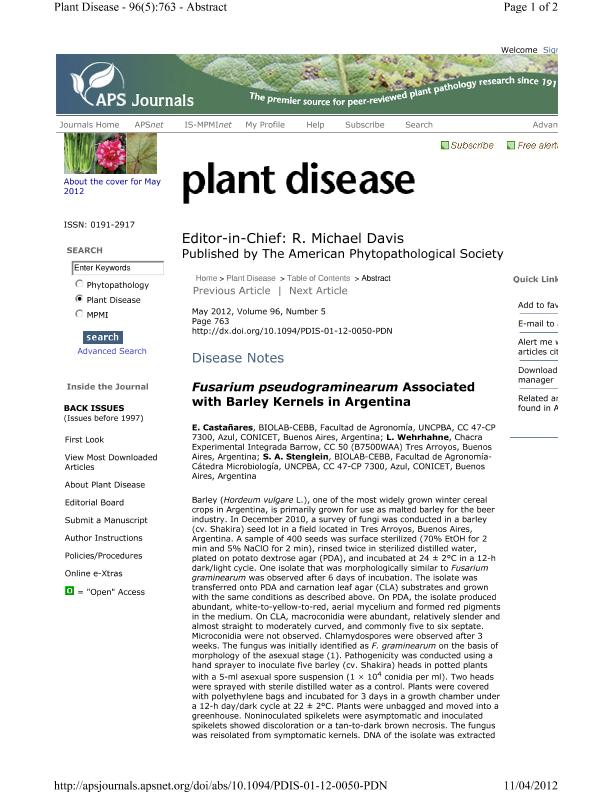Mostrar el registro sencillo del ítem
dc.contributor.author
Castañares, Eliana

dc.contributor.author
Wehrhahne, L.
dc.contributor.author
Stenglein, Sebastian Alberto

dc.date.available
2021-12-16T15:58:03Z
dc.date.issued
2012-05
dc.identifier.citation
Castañares, Eliana; Wehrhahne, L.; Stenglein, Sebastian Alberto; Fusarium pseudograminearum associated with barley kernels in Argentina; American Phytopathological Society; Plant Disease; 96; 5; 5-2012; 1-2
dc.identifier.issn
0191-2917
dc.identifier.uri
http://hdl.handle.net/11336/148889
dc.description.abstract
Barley (Hordeum vulgare L.), one of the most widely grown winter cereal crops in Argentina, is primarily grown for use as malted barley for the beer industry. In December 2010, a survey of fungi was conducted in a barley (cv. Shakira) seed lot in a field located in Tres Arroyos, Buenos Aires, Argentina. A sample of 400 seeds was surface sterilized (70% EtOH for 2 min and 5% NaClO for 2 min), rinsed twice in sterilized distilled water, plated on potato dextrose agar (PDA), and incubated at 24 ± 2°C in a 12-h dark/light cycle. One isolate that was morphologically similar to Fusarium graminearum was observed after 6 days of incubation. The isolate was transferred onto PDA and carnation leaf agar (CLA) substrates and grown with the same conditions as described above. On PDA, the isolate produced abundant, white-to-yellow-to-red, aerial mycelium and formed red pigments in the medium. On CLA, macroconidia were abundant, relatively slender and almost straight to moderately curved, and commonly five to six septate. Microconidia were not observed. Chlamydospores were observed after 3 weeks. The fungus was initially identified as F. graminearum on the basis of morphology of the asexual stage (1). Pathogenicity was conducted using a hand sprayer to inoculate five barley (cv. Shakira) heads in potted plants with a 5-ml asexual spore suspension (1 × 104 conidia per ml). Two heads were sprayed with sterile distilled water as a control. Plants were covered with polyethylene bags and incubated for 3 days in a growth chamber under a 12-h day/dark cycle at 22 ± 2°C. Plants were unbagged and moved into a greenhouse. Noninoculated spikelets were asymptomatic and inoculated spikelets showed discoloration or a tan-to-dark brown necrosis. The fungus was reisolated from symptomatic kernels. DNA of the isolate was extracted (3) and the isolate was identified to species by sequencing the reductase (RED), trichothecene 3-O-acetyltransferase (tri101), and translation elongation factor (TEF) regions (4). The sequences were compared with those in GenBank. The RED sequence (Accession No. JQ350697) showed 100% similarity, the tri101 (Accession No. JQ350698) showed 99% similarity, and the TEF (Accession No. JQ350699) showed 100% similarity with several F. pseudograminearum sequences. Additionally, the isolate was tested for the potential to produce deoxinyvalenol (DON) using a PCR approach that allows identification of two acetylated forms of DON: 15-acetyl-DON (15-ADON) and 3-ADON (2). A PCR product indicative of a 3-ADON genotype was obtained. To our knowledge, this is the first report of F. pseudograminerum associated with barley kernels in Argentina. Considering its potential to cause head blight and product mycotoxins, a large-scale survey of F. pseudograminearum on barley crops in Argentina is underway. A voucher culture (No. 1154) has been deposited in the Culture Collection of the La Plata Spegazzini Institute. References: (1) J. F. Leslie and B. A. Summerell. The Fusarium Laboratory Manual. Blackwell Publishing, Oxford, UK. 2006. (2) A. Quarta et al. Food Addit. Contam. 22:309, 2005. (3) S. A. Stenglein and P. A. Balatti. Physiol. Mol. Plant Pathol. 68:158, 2006. (4) T. J. Ward et al. Fungal Genet. Biol. 45:473, 2008.
dc.format
application/pdf
dc.language.iso
eng
dc.publisher
American Phytopathological Society

dc.rights
info:eu-repo/semantics/openAccess
dc.rights.uri
https://creativecommons.org/licenses/by-nc-sa/2.5/ar/
dc.subject
FUSARIUM PSEUDOGRAMINEARUM
dc.subject
BARLEY
dc.subject.classification
Agronomía, reproducción y protección de plantas

dc.subject.classification
Agricultura, Silvicultura y Pesca

dc.subject.classification
CIENCIAS AGRÍCOLAS

dc.title
Fusarium pseudograminearum associated with barley kernels in Argentina
dc.type
info:eu-repo/semantics/article
dc.type
info:ar-repo/semantics/artículo
dc.type
info:eu-repo/semantics/publishedVersion
dc.date.updated
2021-12-03T19:46:59Z
dc.identifier.eissn
1943-7692
dc.journal.volume
96
dc.journal.number
5
dc.journal.pagination
1-2
dc.journal.pais
Estados Unidos

dc.description.fil
Fil: Castañares, Eliana. Consejo Nacional de Investigaciones Científicas y Técnicas. Centro Cientifico Tecnolológico Mar del Plata. Instituto de Investigaciones en Biodiversidad y Biotecnología. Laboratorio de Biología Funcional y Biotecnología; Argentina
dc.description.fil
Fil: Wehrhahne, L.. Instituto Nacional de Tecnología Agropecuaria. Centro Regional Buenos Aires Sur. Estación Experimental Agropecuaria Barrow; Argentina
dc.description.fil
Fil: Stenglein, Sebastian Alberto. Consejo Nacional de Investigaciones Científicas y Técnicas. Centro Cientifico Tecnolológico Mar del Plata. Instituto de Investigaciones en Biodiversidad y Biotecnología. Laboratorio de Biología Funcional y Biotecnología; Argentina
dc.journal.title
Plant Disease

dc.relation.alternativeid
info:eu-repo/semantics/altIdentifier/url/https://apsjournals.apsnet.org/doi/10.1094/PDIS-01-12-0050-PDN
dc.relation.alternativeid
info:eu-repo/semantics/altIdentifier/doi/https://doi.org/10.1094/PDIS-01-12-0050-PDN
Archivos asociados
